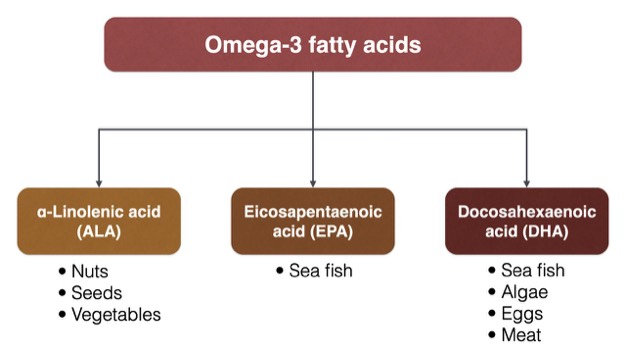Good fats – bad fats?

Dietary fats and their effect on our health have been the subject of a heated debate for decades now. Fats are subdivided into three different classes according to their chemical properties: saturated fatty acids (SFA), monounsaturated fatty acids (MUFA) and polyunsaturated fatty acids (PUFA).
Risk factor saturated fat?
Saturated fatty acids have been subject to criticism for a long time, as they increase the cholesterol production in the liver. High LDL cholesterol levels are an established risk factor for cardiovascular disease, that's why LDL is also called "bad" cholesterol. The recommendation to restrict saturated fats that can be found in butter, lard, or dairy products and meat with high fat content was already given in 1961.
Today, more than 60 years later, there is still a lot of conflicting data. Several countries (e.g. Thailand, India or Sri Lanka) with a high dietary intake of SFAs seem to defy all findings as they all show a very low incidence of cardiovascular disease. There are also many studies that don't show clear signs of a causal relationship between SFA intake and chronic heart disease. As a matter of fact, saturated fats also fulfill important physiological functions. For example, some SFAs inhibit intestinal inflammation or show a supportive effect in fighting cancer cells. So it appears that saturated fats may not be the berated villains of our diets after all – or are they?
But there are good reasons to be cautious. In a review article from 2022 the WHO reinforced its assessment that a high intake of saturated fats has a detrimental impact on health. This conclusion is based on the evaluation of 128 studies over a period of more than 50 years.
Today, more than 60 years later, there is still a lot of conflicting data. Several countries (e.g. Thailand, India or Sri Lanka) with a high dietary intake of SFAs seem to defy all findings as they all show a very low incidence of cardiovascular disease. There are also many studies that don't show clear signs of a causal relationship between SFA intake and chronic heart disease. As a matter of fact, saturated fats also fulfill important physiological functions. For example, some SFAs inhibit intestinal inflammation or show a supportive effect in fighting cancer cells. So it appears that saturated fats may not be the berated villains of our diets after all – or are they?
But there are good reasons to be cautious. In a review article from 2022 the WHO reinforced its assessment that a high intake of saturated fats has a detrimental impact on health. This conclusion is based on the evaluation of 128 studies over a period of more than 50 years.
Why are there so many contradictory studies?
The proportion of macronutrients in the diet is far more important than previously thought – and has not always been considered adequately in previous studies. If you replace one unfavorable macronutrient (e.g. saturated fat) with another unfavorable macronutrient (e.g. sugar), without proper data adjustments this can greatly affect the outcome of a study .
There is a growing body of evidence that not only saturated fats but also carbohydrates with a high glycemic index increase the risk of cardiovascular disease. If the goal is to reduce saturated fats, it is important to consider which nutrients take their place – rapidly digestible carbohydrates from highly processed cereals and sugars are definitely not a suitable alternative, because they promote the formation of particularly small LDL cholesterol molecules that cause plaques in the arteries.
On the other hand, replacing a portion of the saturated fat with polyunsaturated fat or carbohydrates with low glycemic index significantly lowers the risk of heart disease.
Therefore, the majority of public health authorities recommend to limit the total energy intake through saturated fats to a maximum of 10 %. For a diet with 2000 kcal that means that the daily intake should not exceed 20 grams.
There is a growing body of evidence that not only saturated fats but also carbohydrates with a high glycemic index increase the risk of cardiovascular disease. If the goal is to reduce saturated fats, it is important to consider which nutrients take their place – rapidly digestible carbohydrates from highly processed cereals and sugars are definitely not a suitable alternative, because they promote the formation of particularly small LDL cholesterol molecules that cause plaques in the arteries.
On the other hand, replacing a portion of the saturated fat with polyunsaturated fat or carbohydrates with low glycemic index significantly lowers the risk of heart disease.
Therefore, the majority of public health authorities recommend to limit the total energy intake through saturated fats to a maximum of 10 %. For a diet with 2000 kcal that means that the daily intake should not exceed 20 grams.
What about polyunsaturated fatty acids?
PUFAs are said to be the "healthy" fats in our diet. They are subdivided into omega-6 fatty acids and omega-3 fatty acids. They are essential for us and need to be a part of our diet. Contrary to SFAs or MUFAs our body is not able to synthesize them.
Omega-3 fatty acids

▲Figure 1: The most important omega-3 fatty acids and their main dietary sources.
Omega-3 fats are particulary beneficial to our health, especially eicosapentaenic acid (EPA) and docosahexaenic acid (DHA). They mainly occur in seafood and only to a minor degree in meat, milk or eggs. With the exception of algae they cannot be found in plant-based foods. These omega-3s reduce countless risk factors associated with cardiovascular disease: They reduce blood pressure and inflammation, and they have a positive effect on asthma, arthritis, psoriasis, depression and are protective against cancer.
Omega-6 fatty acids
Omega-6 fats, of which linolic acid is the main source in our diet, are a fundamental component of our cell membranes and play an important role in forming metabolites that are needed for inflammatory processes in the body. Omega-6 and omega-3 fats have a quite opposite effect. Therefore, it is necessary that the ratio between the two is in balance. An excessive intake of linolic acid promotes the formation of pro-inflammatory signaling molecules. Also, a diet overly rich in omega-6 and very low in omega-3 may be a factor in developing chronic disease. This is why recently the omega-6 to omega-3 ratio has received growing attention in research. It is still unknown how much linolic acid is actually too much, but it is estimated that a ratio of about 5:1 is favorable. However, currently the intake of omega-6 fats is 15 to 40 times higher than the intake of omega-3. Several vegetable oils, such as sunflower oil, that are used in large quantities in our diet, even show an extremely out of balance ratio of more than 200:1!
Some vegetable oils are also subject to criticism for another reason: A big proportion of our omega-6 intake comes from deep-fat frying oils, but polyunsaturated fatty acids are not resistant to heating. High temperature treatment, e.g. frying, may transform them into trans-fats or other harmful oxidation products. A substantial proportion of residues in the arteries consists of those harmful by-products. Trans-fats show a strong correlation with cardiovascular disease and are about to be banned in the U.S.
Some vegetable oils are also subject to criticism for another reason: A big proportion of our omega-6 intake comes from deep-fat frying oils, but polyunsaturated fatty acids are not resistant to heating. High temperature treatment, e.g. frying, may transform them into trans-fats or other harmful oxidation products. A substantial proportion of residues in the arteries consists of those harmful by-products. Trans-fats show a strong correlation with cardiovascular disease and are about to be banned in the U.S.
How can you improve the ratio of omega-6 to omega-3?
Basically one could just reduce the intake of omega-6, as this would autmatically improve the omega-6 to omega-3 ratio. However, it's the absolute intake of omega-3 that is crucial. 250 mg EPA + DHA per day are necessary to prevent disease and ensure a proper physiological function. Several authorities even recommend twice that amount. Many countries all over the world have insufficient intakes of these two essential nutrients.
With the exception of some algae, EPA and DHA can be found exclusively in animal products. However, the body can synthesize them to a restricted extent from the omega-3 fatty acid α-linolenic acid. The conversion rate in men is very low, less than 5 %, women can convert between 5 and 10 %. The conversion rate is also strongly dependent on the omega-6 intake, as both classes of fatty acids compete for the same conversion enzymes: excessive omega-6 decreases the production of EPA and DHA. Therefore vegetarians should watch their intake of omega-3 very carefully and if necessary supplement with a plant based omega-3 source (e.g. algae oil extracts).
Back to overview
With the exception of some algae, EPA and DHA can be found exclusively in animal products. However, the body can synthesize them to a restricted extent from the omega-3 fatty acid α-linolenic acid. The conversion rate in men is very low, less than 5 %, women can convert between 5 and 10 %. The conversion rate is also strongly dependent on the omega-6 intake, as both classes of fatty acids compete for the same conversion enzymes: excessive omega-6 decreases the production of EPA and DHA. Therefore vegetarians should watch their intake of omega-3 very carefully and if necessary supplement with a plant based omega-3 source (e.g. algae oil extracts).
Back to overview

